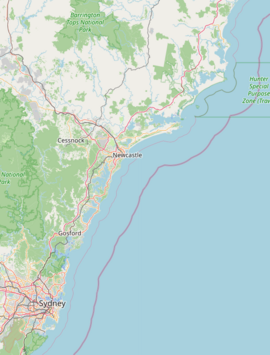Seahampton, New South Wales facts for kids
Quick facts for kids SeahamptonGreater Newcastle, New South Wales |
|||||||||||||||
|---|---|---|---|---|---|---|---|---|---|---|---|---|---|---|---|
| Population | 311 (2011 census) | ||||||||||||||
| • Density | 620/km2 (1,600/sq mi) | ||||||||||||||
| Postcode(s) | 2286 | ||||||||||||||
| Area | 0.5 km2 (0.2 sq mi) | ||||||||||||||
| Location | |||||||||||||||
| LGA(s) |
|
||||||||||||||
| Parish | Teralba | ||||||||||||||
| State electorate(s) | Cessnock | ||||||||||||||
| Federal Division(s) | Hunter | ||||||||||||||
|
|||||||||||||||
Seahampton is a small community, sometimes called a 'hamlet'. It is located north of West Wallsend, in New South Wales, Australia. It's about 21 kilometers (13 miles) west of Newcastle's main city area. You'll also find it west of the big Sydney-Newcastle Freeway. Seahampton is part of the City of Lake Macquarie local government area.
The story of Seahampton began with coal mining. A coal mine called Seaham No. 1 Colliery opened here on March 6, 1890. It was started by the Monkwearmouth Coal Company. This company later changed its name to the Seaham Coal Company Ltd.
The mine shaft went very deep, about 460 feet (140 meters) down. It reached a coal layer called the Borehole seam. This seam was about five feet nine inches thick.
At its busiest, the mine could dig out 1,450 tons of coal every day! The coal was then sent by the company's own train line. It connected to the main government railway line at Cockle Creek Junction.
Sadly, the colliery closed on July 7, 1932. This happened during a tough time called the Great Depression. The mine never opened again after that.
The town of Seahampton was planned out in 1889. This was to create places for the mine workers to live.
History
The first people to live in this area were the Aboriginal people. They were part of the Awabakal group. They were the original owners of this land.



